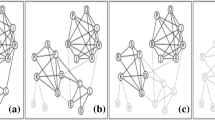Abstract
We examine whether the prominence of individuals in different social networks is determined by their position in their community, the whole network or by the location of their community within the network. To this end, we introduce two new measures of centrality, both based on communities in the network: local and community centrality. Community centrality is a novel concept that we introduce to describe how central one’s community is within the whole network. We introduce an algorithm to estimate the distance between communities and use it to find the centrality of communities. Using data from several social networks, we show that central communities incorporate actors who are involved in mainstream activities for that network. We then conduct a detailed study of different social networks and determine how various global measures of prominence relate to structural centrality measures. We show that depending on the underlying measure of prominence, different combinations of local, global and community centrality play an important role in determining the prominence. Local and community centrality measures add new information on top of existing global measures. We show robustness of our results by studying different partitions of the data and different clustering methods. Our deconstruction of centrality allows us to study the underlying processes that contribute to prominence in more detail and develop more detailed and accurate models.






Similar content being viewed by others
Notes
The implementation of this algorithm is given in http://www.cs.rpi.edu/~magdon/LFDlabpublic.html/software.html?
References
Adalı S, Lu X, Magdon-Ismail M (2012) Attentive betweenness centrality (abc): considering options and bandwidth when measuring criticality. In: 2012 ASE/IEEE international conference on social computing
Adalı, S, Lu X, Magdon-Ismail M (2013) Deconstructing centrality: thinking locally and ranking globally in networks. In: Proceedings of 2013 IEEE/ACM international conference on advances in social networks analysis and mining (ASONAM 2013)
Adamic L, Adar E (2003) Friends and neighbors on the web. Soc Netw 25(3):211–230
Borgatti SP, Everett MG (2006) A graph-theoretic perspective on centrality. Soc Netw 28(4):466–484
Clauset A, Newman MEJ, Moore C (2004) Finding community structure in very large networks. Phys Rev E 70(6):066111
Cormen TH, Leiserson CE, Rivest RL, Stein C (2009) Introduction to algorithms, 3rd edn. The MIT Press, Cambridge
De Vany A (2004) Hollywood economics: how extreme uncertainty shapes the film industry. Routledge, London
Everett M, Borgatti SP (2005) Extending centrality. Cambridge University Press, Cambridge
Freeman LC (1979) Centrality in social networks: conceptual clarification. Soc Netw 1(3):215–239
Palla IFG, Derenyi I, Vicsek T (2005) Uncovering the overlapping community structure of complex networks in nature and society. Nature, 814–818
Guimera R, Amaral L (2004) Modeling the world-wide airport network. Eur Phys J B 38:381–385
Hirsch J (2005) An index to quantify an individual’s scientific research output. Proc Natl Acad Sci 46:16569–16572
Kourtellis N, Alahakoon T, Simha R, Iamnitchi A, Tripathi R (2013) Identifying high betweenness centrality nodes in large social networks. Soc Netw Anal Min 3(4):899–914
Langville A, Meyer C (2005) Deeper inside pagerank. Internet Math 1:335–380
Magdon-Ismail M, Purnell J (2011) Ssde-cluster: fast overlapping clustering of networks using sampled spectral distance embedding and gmms. In: IEEE international conference on social computing
Pfeffer J, Carley K (2012) k-centralities: local approximations of global measures based on shortest paths. In: Proceedings of WWW 2012 LSNA’12 workshop, pp 1044–1050
Pons P, Latapy M (2005) Computing communities in large networks using random walks. In: Proc. 20th comp. and inf. sc., pp 284–293
Rees B, Gallagher K (2012) Overlapping community detection using a community optimized graph swarm. Soc Netw Anal Min 2(4):405–417
Salganik MJ, Watts DJ (2009) Web-based experiments for the study of collective social dynamics in cultural markets. Topics Cognit Sci 1(3):439–468
Scott J (2012) Social network analysis. SAGE Publications Limited, New York
Stephenson K, Zelen M (1989) Rethinking centrality: methods and examples. Soc Netw 11(1):1–37
Sun Y, Yu Y, Han J (2009) Ranking-based clustering of heterogeneous information networks with star network schema. In: Proc. 15th SIGKDD, pp 797–806
Vasudevan M, Deo N (2012) Efficient community identification in complex networks. Soc Netw Anal Min 2(4):345–359
Wasserman S, Faust K (1994) Social network analysis: methods and applications. Cambridge University Press, Cambridge
Wu HC, Luk RWP, Wong KF, Kwok KL (2008) Interpreting tf-idf term weights as making relevance decisions. ACM Trans Inf Syst (TOIS) 26(3):13:1–13:37
Zhao J, Ding GH, Tao L, Yu H, Yu ZH, Luo JH, Cao ZW, Li YX (2007) Modular co-evolution of metabolic networks. BMC Bioinform
Acknowledgments
The research was sponsored by the Army Research Laboratory and was accomplished under Cooperative Agreement Number W911NF-09-2-0053. Xiahui Lu is supported by DARPA SMISC program via a subcontract to RPI from Sentametrix. The views and conclusions contained in this document are those of the authors and should not be interpreted as representing the official policies, either expressed or implied, of the Army Research Laboratory or the US Government. The US Government is authorized to reproduce and distribute reprints for government purposes notwithstanding any copyright notation here on.
Author information
Authors and Affiliations
Corresponding author
Rights and permissions
About this article
Cite this article
Adalı, S., Lu, X. & Magdon-Ismail, M. Local, community and global centrality methods for analyzing networks. Soc. Netw. Anal. Min. 4, 210 (2014). https://doi.org/10.1007/s13278-014-0210-8
Received:
Revised:
Accepted:
Published:
DOI: https://doi.org/10.1007/s13278-014-0210-8




